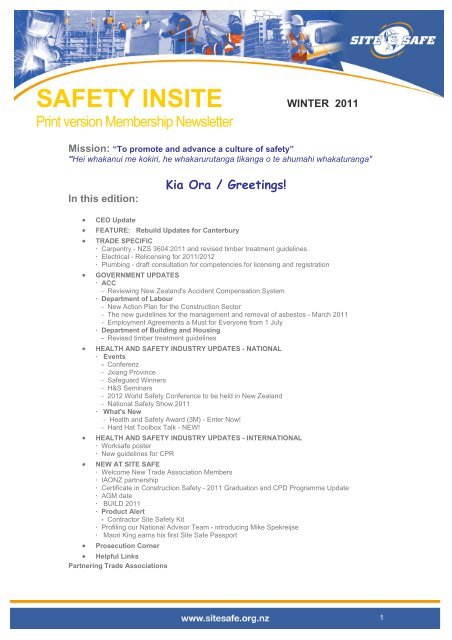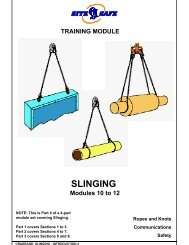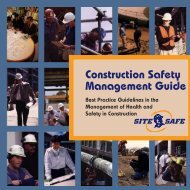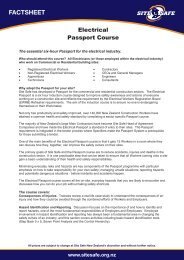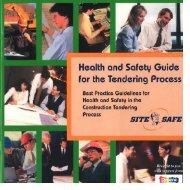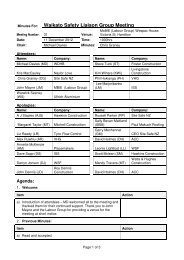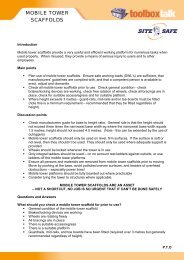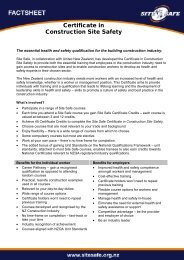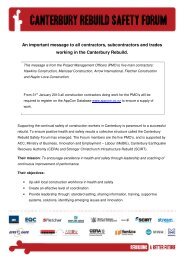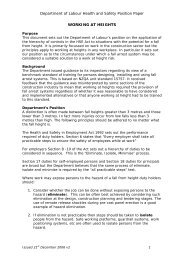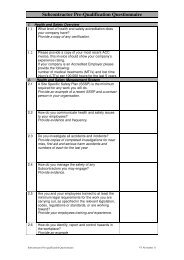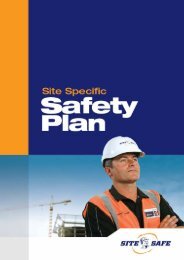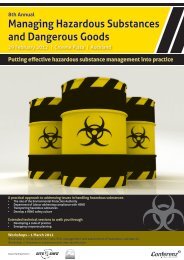SAFETY INSITE WINTER 2011 - Site Safe
SAFETY INSITE WINTER 2011 - Site Safe
SAFETY INSITE WINTER 2011 - Site Safe
You also want an ePaper? Increase the reach of your titles
YUMPU automatically turns print PDFs into web optimized ePapers that Google loves.
<strong>SAFETY</strong> <strong>INSITE</strong> <strong>WINTER</strong> <strong>2011</strong><br />
Print version Membership Newsletter<br />
Mission: “To promote and advance a culture of safety”<br />
"Hei whakanui me kokiri, he whakarurutanga tikanga o te ahumahi whakaturanga"<br />
In this edition:<br />
Kia Ora / Greetings!<br />
• CEO Update<br />
• FEATURE: Rebuild Updates for Canterbury<br />
• TRADE SPECIFIC<br />
· Carpentry - NZS 3604:<strong>2011</strong> and revised timber treatment guidelines<br />
· Electrical - Relicensing for <strong>2011</strong>/2012<br />
· Plumbing - draft consultation for competencies for licensing and registration<br />
• GOVERNMENT UPDATES<br />
· ACC<br />
- Reviewing New Zealand's Accident Compensation System<br />
· Department of Labour<br />
- New Action Plan for the Construction Sector<br />
- The new guidelines for the management and removal of asbestos - March <strong>2011</strong><br />
- Employment Agreements a Must for Everyone from 1 July<br />
· Department of Building and Housing<br />
- Revised timber treatment guidelines<br />
• HEALTH AND <strong>SAFETY</strong> INDUSTRY UPDATES - NATIONAL<br />
· Events<br />
- Conferenz<br />
- Jxiang Province<br />
- <strong>Safe</strong>guard Winners<br />
- H&S Seminars<br />
- 2012 World <strong>Safe</strong>ty Conference to be held in New Zealand<br />
- National <strong>Safe</strong>ty Show <strong>2011</strong><br />
· What's New<br />
- Health and <strong>Safe</strong>ty Award (3M) - Enter Now!<br />
- Hard Hat Toolbox Talk - NEW!<br />
• HEALTH AND <strong>SAFETY</strong> INDUSTRY UPDATES - INTERNATIONAL<br />
· Worksafe poster<br />
· New guidelines for CPR<br />
• NEW AT SITE SAFE<br />
· Welcome New Trade Association Members<br />
· IAONZ partnership<br />
· Certificate in Construction <strong>Safe</strong>ty - <strong>2011</strong> Graduation and CPD Programme Update<br />
· AGM date<br />
· BUILD <strong>2011</strong><br />
· Product Alert<br />
- Contractor <strong>Site</strong> <strong>Safe</strong>ty Kit<br />
· Profiling our National Advisor Team - introducing Mike Spekreijse<br />
· Maori King earns his first <strong>Site</strong> <strong>Safe</strong> Passport<br />
• Prosecution Corner<br />
• Helpful Links<br />
Partnering Trade Associations<br />
1
CEO Update<br />
While compiling this edition of the <strong>Safe</strong>ty Insite, significant earthquakes<br />
have continued to shake Christchurch. With the major increase of work<br />
now in Christchurch, a high-vis is now more common than a Crusader<br />
rugby jersey. We have taken direction as to how to best service the<br />
region and you will find more detail around this throughout this <strong>Safe</strong>ty<br />
Insite Winter edition.<br />
<strong>Site</strong> <strong>Safe</strong> has been part of discussions with Health and <strong>Safe</strong>ty<br />
Managers from the major Charter companies to facilitate and support<br />
healthy and safe workplaces during earthquake remedial work. The<br />
work going on in Canterbury has spear-headed continued improvement<br />
for our services through New Zealand. Specifically, the topic of discussion with the Charter<br />
companies has been around extending renewal dates of higher level cards and backing that<br />
up with E-learning as well as additional on-site audits. We have also launched the ‘Contractor<br />
<strong>Site</strong> <strong>Safe</strong>ty Kit’ which assists smaller sized businesses with everything they need to make<br />
sure their site meets health and safety requirements.<br />
Our National team of <strong>Safe</strong>ty, Health and Environmental Advisors has four new staff since<br />
February and continues to grow in number and capability to support members and to deliver<br />
on their changing needs. The team has been working on a rotational basis to assist our<br />
Christchurch staff. Our Advisor Chris Graney will shortly be relocating to Kati Kati and<br />
servicing the Waikato and Bay of Plenty region. We are also looking to locate an Advisor in<br />
the Northland region.<br />
I would also like to formally welcome four new trade associations to <strong>Site</strong> <strong>Safe</strong> membership:<br />
Brick & Blocklayers Federation, Fencing Contractors Association, New Zealand Sign &<br />
Display Association, and Insulation Association of New Zealand. These partnerships mean<br />
that we will be able to hear more from New Zealand companies and their unique needs and<br />
see where we can improve to assist better health and safety in construction.<br />
On one final note, in March, Land Search and Rescue wrote to me to thank <strong>Site</strong> <strong>Safe</strong> for<br />
allowing our Canterbury Advisor Kevin Wood to volunteer his time during the earthquake red<br />
alert period. This organization visited and reported on 56,000 households of people in need<br />
around Christchurch. I would just like to state my admiration and pride for Kevin, our Southern<br />
Regional Manager Richard, and all of our Christchurch office staff who are still smiling at<br />
work, in their communities and on the home front.<br />
As an industry organisation dedicated to promoting and advancing a culture of safety in the<br />
construction industry <strong>Site</strong> <strong>Safe</strong> is constantly investigating world wide for best practices to<br />
introduce into New Zealand to better serve our members. As always, I encourage our readers<br />
to contact <strong>Site</strong> <strong>Safe</strong> with questions or ideas. Thank you for your continued support, and we<br />
look forward to seeing you at the <strong>Site</strong> <strong>Safe</strong> Annual General Meeting on 7 September in<br />
Wellington.<br />
Garry Menhennet, <strong>Site</strong> <strong>Safe</strong> Chief Executive<br />
2
Feature: Canterbury Rebuild<br />
To support healthy and safe workplaces during earthquake remedial work <strong>Site</strong> <strong>Safe</strong> has been<br />
facilitating coordination between Health and <strong>Safe</strong>ty Managers from the major construction<br />
companies, ACC and the Department of Labour. From 23 June "The majority of greater<br />
Christchurch properties – about 100,000 – have today been given a green light to go ahead<br />
with their repair and rebuilding of their homes," Hon Brownlee said. <strong>Site</strong> <strong>Safe</strong> will help pass<br />
on more Canterbury rebuild official information as it is released.<br />
Governance<br />
A new alliance group has been established to coordinate<br />
infrastructure rebuild work in Christchurch. The alliance<br />
includes the Christchurch Earthquake Recovery Authority<br />
(CERA), Christchurch City Council (CCC), Fletcher<br />
Construction, Fulton Hogan, Downer Construction, MacDow<br />
New Zealand and City Care. The alliance will use<br />
construction labour from within the Canterbury community.<br />
The alliance is responsible for ground level and<br />
underground infrastructure such as roads and waterways.<br />
Over three quarters of storm water pipes have been<br />
damaged. The civil industry has been quick to make the<br />
necessary repairs clearly visible by the many scars on the<br />
roads.<br />
Earthquake Commission - for work costing between<br />
$10,000 and $100,000<br />
The Earthquake Commission has set up the Project Management Office EQR (for Earthquake<br />
Recovery), and appointed Fletcher Construction as the principal. This is for work costing<br />
between $10,000 and $100,000. <strong>Site</strong> <strong>Safe</strong> has been providing safety induction for contractors<br />
and tradespersons who will be working for Fletcher Construction under the Earthquake<br />
Recovery banner. <strong>Site</strong> <strong>Safe</strong> have recently launched the ‘Contractor <strong>Site</strong> <strong>Safe</strong>ty Kit’ which<br />
assists smaller sized businesses get a head start on their health and safety requirements for<br />
the earthquake recovery work.<br />
Private insurance – for work costing over $100,000<br />
There are three main insurance companies who are handling claims over $100,000 – AMI,<br />
State and Vero. Main construction contractors who are undertaking contracts are Hawkins<br />
Construction, Mainzeal and Arrow International. Workers and businesses are to comply with<br />
<strong>Site</strong> <strong>Safe</strong> passport and site specific safety planning as required in all other major work.<br />
The building scene – shaky ground<br />
Buildings are a combination of parts which sits on land – which is now constantly moving. A<br />
whole raft of issues may come out of an after-shock which can sometimes happen at night.<br />
What began in September as a minor issue is by now, a major issue. To give an idea of how<br />
unstable the ground is; driving around the Christchurch suburb of Kaiapoi, signs read “your<br />
speed shakes our homes” and cars are encouraged to stay under 30 kms per hour.<br />
Construction sites are to be monitored at least daily to see whether new hazards have arisen.<br />
3
Construction workers – health and safety concerns<br />
Key issues facing Cantabrians are now chronic fatigue, stress and anxiety resulting from the<br />
three major earthquakes and over 7000 aftershocks. Throughout the shaky period since last<br />
September, the main hazards for construction workers to watch for have been:<br />
• Keeping public safe<br />
• People working at height with no plan to stop themselves from falling<br />
• The amount of dust and other poisons (such as asbestos) in the atmosphere from<br />
the amount of demolition - this can be partly controlled by dampening down the<br />
affected area with a hose<br />
• Confined space work in demolition sites<br />
• Do workers have an emergency plan?<br />
The legal side<br />
From 19 May <strong>2011</strong> within the three local authority areas in greater Christchurch: Christchurch<br />
City, Waimakariri, and Selwyn District Councils the following laws have been passed by the<br />
Department of Building and Housing. The seismic hazard factor for the design of all buildings<br />
has increased by 35 per cent from 0.22 to 0.3. Additionally, concrete floor foundations for<br />
housing will need to be tied and reinforced. These changes are likely to increase new<br />
residential building work costs from $2,000 to $9,000 per property, depending on the house<br />
size, foundation and the state of the ground.<br />
For more information about what the government has organised for the Canterbury<br />
earthquake recovery:<br />
www.beehive.govt.nz/feature/special-feature-canterbury-earthquakes-recovery<br />
To read the Canterbury Earthquake Recovery Act <strong>2011</strong><br />
www.legislation.govt.nz/act/public/<strong>2011</strong>/0012/latest/DLM3653522.html<br />
As you drive around Christchurch the enormous amount of work is visible, however, with the<br />
necessary public consultancy and engineering planning to be done – the timing of workflow is<br />
uncertain. Once work gets more underway, the sheer enormity of the work must not<br />
undermine safe working practises. While Cantabrians need to have their buildings restored<br />
and rebuilt, it is vital that the rebuilding is designed and built properly and takes into account<br />
what has been learnt from the past earthquakes – healthier, safer and more sustainable<br />
construction. No more injuries and deaths need to come out of the rebuild of Canterbury.<br />
Trade Specific<br />
Builders<br />
NZS 3604:<strong>2011</strong><br />
The revised timber-framed buildings Standard - NZS 3604:<strong>2011</strong> is available now. NZS 3604<br />
provides guidance to builders, architects, engineers, designers, and students for the design<br />
and construction of timber-framed structures not requiring specific engineering design. The<br />
Standard is a core resource for building consent authorities determining compliance with the<br />
New Zealand Building Code.<br />
For information about what's new with timber treatment go to the Department of Building and<br />
Housing website.<br />
4
Electrical - Re-Licensing for <strong>2011</strong>/2012<br />
From the 23 May <strong>2011</strong> the Electrical Workers Registration<br />
Board contacted all registered electricians to advise them to<br />
apply to renew their licenses online at<br />
http://ewr.dbh.govt.nz/OnlineAccount/Login.aspx .<br />
<strong>Site</strong> <strong>Safe</strong> offers the safety refresher training (including CPR<br />
and Basic First Aid training) in line with the Electrical Workers<br />
Registration Board requirements on the <strong>Site</strong> <strong>Safe</strong> Electrical<br />
Passport.<br />
For more information see:<br />
Electrical Workers Registration Board website @ www.ewrb.govt.nz<br />
- under Training<br />
The <strong>Site</strong> <strong>Safe</strong> Electrical Passport Training Course on www.sitesafe.org.nz<br />
Plumbing, Gasfitters and Drainlayers Board<br />
Public consultation opens for the Plumbing, Gasfitters and Drainlayers Board draft<br />
competencies for registration and licensing.<br />
Click here to go to the Plumbing, Gasfitters and Drainlayers Board website and see the<br />
document.<br />
Submissions close on 11 July <strong>2011</strong>.<br />
Government Updates<br />
ACC<br />
Reviewing New Zealand's Accident Compensation System<br />
Past, current and future arrangements for accident compensation in New Zealand were<br />
debated at a conference about the acc scheme in Wellington during May <strong>2011</strong>. The<br />
conference provided a forum for debate about accident compensation by industry<br />
representatives, academics, private insurers, and politicians.<br />
The original concept of the acc Scheme, arising from the Woodhouse Report in the early<br />
1970’s was examined along with presenters who covered topics such as the private insurers’<br />
perspective, disputes resolution, experience rating and overseas experience with experience<br />
rating and competition.<br />
A highlight was the address by Hon David Caygill who led a Government Stocktake of acc<br />
and its accounts. A report on the stocktake’s findings was produced earlier this year and the<br />
5
Government has since signalled its intention os matters such as opening up the acc Work<br />
account to competition. The stocktake noted the acc accredited Employer Programme was<br />
proving successful. This programme mainly covers larger employers who manage their own<br />
risk and accident insurance. The stocktake found that employers in this programme achieved<br />
lower inured injury rates and costs than other employers. The Government has considered<br />
the stocktake’s finding and made decisions such as;<br />
• more employers will encouraged to join the accredited employer Programme due it’s<br />
success in reducing injuries and costs<br />
• the acc Work account will be opened to competition. This means that other insurers<br />
besides acc will be able to offer workplace accident insurance from April 2012<br />
The Department of Labour has commenced public consultation to progress these matters.<br />
Specifically the consultation is eeking views on proposals to :<br />
• extending the accredited Employers programme and offering other risk-sharing<br />
options<br />
• introducing choice in the acc Work account<br />
Submissions need to be made by 5pm on 15 July <strong>2011</strong>. Details can be found on<br />
www.dol.govt.nz/consultation/increasing-choice/<br />
acc has recently published a Statement of Intent for <strong>2011</strong>-2014. The document indicates<br />
where acc will focus its efforts. One area of focus listed will be improving the choice and<br />
range of products for businesses, and be able to adapt to meet needs and expectations. (For<br />
details go to www.acc.co.nz )<br />
Department of Labour<br />
New Action Plan To Reduce Construction Injuries<br />
The Hon Kate Wilkinson, the Minister of Labour has launched a new Construction Sector<br />
Action Plan that sets a broad direction to reduce injuries in the construction industry over the<br />
next 3 years. The launch took place on 26 May <strong>2011</strong> at a Kaiapoi construction site, just north<br />
of Christchurch.<br />
Published by the Department of Labour, the Action Plan was developed following consultation<br />
in 2010 with various industry organisations including employers, unions, safety, training and<br />
the newly established Construction <strong>Safe</strong>ty Council.<br />
The Action Plan includes four ‘action areas’ which are broad based initiatives aimed at<br />
reducing the construction industry injury toll. There is a primary focus on slips, trips and falls<br />
from heights. The intention is to include all parts of the industry over the next 3 years in<br />
activities such as:<br />
• significantly reduce workplace injury and fatality rates<br />
• put effective programmes in place to achieve the injury reductions<br />
• provide reliable health and safety data<br />
• create partnerships with government and industry to improve health and safety<br />
Similar action plans for other industries such as agriculture, manufacturing, forestry and<br />
fishing are under development.<br />
6
<strong>Site</strong> <strong>Safe</strong> will continue to work with the Department and ACC under an existing partnership<br />
agreement to promote Member’s views and priorities for activities that will best reduce<br />
construction injuries.<br />
The Construction Sector Action Plan can be viewed on www.dol.govt.nz<br />
Employment Agreements - A Must For Everyone<br />
From 1 July <strong>2011</strong>, all employers must keep a copy of every employee's signed employment<br />
agreement or current terms and conditions of employment. This requirement also extends to<br />
employers who have hired employees on a verbal agreement.<br />
See the Department of Labour website for more information.<br />
The New Zealand Guidelines for the Management and Removal of Asbestos - March<br />
<strong>2011</strong><br />
These comprehensive guidelines provide extensive information on safe and compliant<br />
asbestos management and removal processes, specifically targeting those within the<br />
asbestos removal industry, Consultants, Clients and Employers and Building Owners.<br />
You can view the html version of the guideline page on the Department of Labour website or<br />
the guide is available for purchase from New Zealand Demolition and Asbestos Association<br />
Department of Building and Housing<br />
What's new with timber treatment?<br />
The Acceptable Solution B2/AS1 has changed. The timber<br />
treatment hazard class H1.2 is now required for radiata pine<br />
and Douglas fir timber in buildings, where it is protected from<br />
the weather (ie. enclosed timber framing). Research shows that<br />
H1.2 gives framing timber good protection from decay. H1.2<br />
boron treatment is colour-coded pink.<br />
From 1 July <strong>2011</strong> onwards, only the new B2/AS1 can be used<br />
as an Acceptable Solution.<br />
Health and <strong>Safe</strong>ty<br />
Timber treatments generally consist of chemicals that need to<br />
be handled safely and appropriately. Important measures to take when using treated timber,<br />
especially hazard classes H3 and above, are:<br />
• reduce contact by wearing gloves, goggles and a dust mask<br />
• don't burn off-cuts or cook with them<br />
• dispose of waste in an approved landfill<br />
• wash your hands before using the toilet, smoking or eating<br />
• wash work clothes separately<br />
7
• ventilate work spaces as much as you can<br />
• working with solvent-damp timber is not advised, solvent-damp timber should be<br />
allowed to properly dry off before use.<br />
Note: Boron has been used commercially as a timber preservative in New Zealand since the<br />
1950s, with no known health issues for timber users or building inhabitants.<br />
For more information and to read the The Building Code and Acceptable Solution B2/AS1<br />
quick guide booklet, see www.dbh.govt.nz/pink-is-tough-timber-treatment<br />
This document is issued as guidance under section 175 of the Building Act 2004.<br />
Health and <strong>Safe</strong>ty Updates – National<br />
Events<br />
Conferenz<br />
Health and <strong>Safe</strong>ty in Construction<br />
29 - 30 August <strong>2011</strong>, Rendezvous Hotel, Auckland<br />
The Health and <strong>Safe</strong>ty in the Construction Forum will showcase case studies and<br />
presentations from leading figures in the construction industry, offer practical tips on how to<br />
improve your organisations health and safety performance and discuss future government<br />
strategies in the development of safer construction sector.<br />
This event will focus on construction specific safety risks:<br />
• Achieving better health and safety outcomes during construction projects through<br />
greater pre construction health and safety planning<br />
• Emergency response health and safety plans on a work site<br />
• Monitoring and measuring health and safety performance<br />
• Reworking work flows and job processes to develop a safer workplace<br />
• Investigating accidents and near misses<br />
• Effective health and safety management plans in high risk projects<br />
Secure your place today by phoning Conferenz on (09) 912 3616 or email us at<br />
register@conferenz.co.n z .<br />
Register online at www.conferenz.co.nz/conferences/health-safety-construction<br />
8
Jxiang Province<br />
On the 9th May, the Auckland <strong>Site</strong> <strong>Safe</strong> office<br />
received a Government delegation from the Jxiang<br />
province of China. The delegation was lead by<br />
Zheng Le Xian Deputy Director of Work <strong>Safe</strong>ty,<br />
and Kang Bin Emergency Rescue Commander and<br />
were touring Australia and New Zealand to study<br />
how other countries manage workplace safety.<br />
<strong>Site</strong> <strong>Safe</strong>'s Auckland regional manager Russell<br />
Parker talked to them about <strong>Site</strong> <strong>Safe</strong>'s mission<br />
and what activities are currently underway with the<br />
New Zealand construction industry and how that<br />
connects with the New Zealand Health and <strong>Safe</strong>ty<br />
in Employment act 1992.<br />
Parker commented that some interesting points there were raised were that "all construction<br />
workers in the Jxiang province are required to go through a base level training programme<br />
that is payed for by the Government". Parker went on to say" they were amazed that <strong>Site</strong><br />
<strong>Safe</strong> was not more supported and utilised by the Department of Labour to assist in policing<br />
the industry."<br />
The Jxiang province area is over 160000 km2 , and has a population of approximately 39.66<br />
million. Their nominal GDP for 2009 was 765 billion yuan (112.1 billion USD).<br />
<strong>Safe</strong>guard Winners<br />
Congratulations to the following <strong>Site</strong> <strong>Safe</strong> members for winning big at the annual <strong>Safe</strong>guard<br />
health and safety awards.<br />
• Electrix Ltd<br />
• Royal Air New Zealand Airforce<br />
• Jay Lauten from Fletcher Construction<br />
And a big congratulations to the Taranaki <strong>Safe</strong>ty Construction Group for best leadership of an<br />
industry sector<br />
H&S Seminars<br />
Human Factors in Developing a <strong>Safe</strong>ty Culture - 31- August <strong>2011</strong> - Auckland<br />
Key Learning Objective:<br />
- Gain an understanding of the human factors contributing to workplace safety<br />
For more details go to:<br />
http://www.conferenz.co.nz/training/human-factors-developing-safety-culture<br />
9
Reducing Drug & Alcohol Risk in the Workplace - 1- September <strong>2011</strong> - Auckland<br />
Key Learning Objectives:<br />
- Gain an understanding of different drugs being used/abused and their impact on the<br />
workplace<br />
- Understand your legal rights and responsibilities as an employer under OSH and<br />
employment legislation<br />
- Learn how to safely and ethically implement workplace drug testing in your organisation<br />
For more details go to:<br />
http://www.conferenz.co.nz/training/reducing-drug-alcohol-risk-work-place<br />
2012 World <strong>Safe</strong>ty Conference to be held in New Zealand<br />
The 10th World <strong>Safe</strong>ty Conference is going to be held in Wellington 1-5th October 2012. The<br />
theme will be "Connecting pathways for a vibrant and safer future", the conference will bring<br />
together the world's leading injury prevention and safety researchers, practicioners and<br />
advocates. The conference will be organised by ACC, <strong>Safe</strong>r Communities Foundation New<br />
Zealand (SCFNZ), Injury Prevention Research Unit and co-sponsored by the World Health<br />
Organisation.<br />
The conference will have a focus on positive safety culture and safer environments.<br />
For more information see www.conference.co.nz/worldsafety2012<br />
<strong>2011</strong> National <strong>Safe</strong>ty Show - The Latest Innovations, Equipment and Technology!<br />
ASB Showgrounds, Greenlane, Auckland September <strong>2011</strong>, 21-22 September 10am-4pm<br />
This trade show is free for people involved in the safety industry and is the largest event in<br />
New Zealand dedicated to workplace safety and provides those concerned with the<br />
opportunity to explore new products, services and innovations from the safety industry.<br />
<strong>Site</strong> <strong>Safe</strong> New Zealand will be introducing an innovative range of <strong>Safe</strong>ty Manager products.<br />
<strong>Safe</strong>ty Manager has been developed to simplify the health and safety Management<br />
coordination process.<br />
10
What's New<br />
Health and <strong>Safe</strong>ty award (3M) - enter now!<br />
Last year the Taranaki Construction <strong>Safe</strong>ty Group won the 3M award for innovation in health<br />
and safety. The awards now in the ninth year promote excellence in health and safety for the<br />
New Zealand workforce.<br />
The closing date for applications is September 26, <strong>2011</strong>, and entries can be submitted to<br />
3msafetynz@mmm.com. Alternatively, written entries can be posted to 3MNZ Ltd, PO Box<br />
33246, Takapuna, Auckland.<br />
Hard Hat Tool Box Talk - New!<br />
The use of occupational protective helmets, commonly<br />
known as "hard hats", is a common means of protection<br />
from being struck by falling objects or from striking the head<br />
against a fixed or protruding object. Hard hats may also be<br />
required to protect against other hazards such as<br />
inadvertent contact with electricity, exposure to UV, weather,<br />
and extremes of temperature.<br />
• When must hard hats be worn?<br />
• How do you identify signs of wear or damage to a hard hat?<br />
• How do you correctly store a hard hat when not in use?<br />
To find out the answers to these questions and more go to the <strong>Site</strong> <strong>Safe</strong> website or see the<br />
tool box talk at the end of this newsletter.<br />
You can print out the full Toolbox Talk sheet to take to your next safety meeting.<br />
Health and <strong>Safe</strong>ty Industry Updates –<br />
International<br />
CPR Changes<br />
The CPR international committee known as ILCOR (International Liaison Committee on<br />
Resuscitation) reviews all of the research completed on CPR every five years.The key CPR<br />
changes in <strong>2011</strong> are not major like some years, and the most obvious change is that CPR<br />
steps are now the same for all adults, children and infants. This change will also assist all<br />
learning and retention of CPR techniques.<br />
The CPR <strong>2011</strong> guidelines are published on the New Zealand Resuscitation Council (NZRC)<br />
website. For information on CPR courses, visit www.stjohn.org.nz or phone 0800 FIRSTAID<br />
(0800 347 782)<br />
The <strong>Site</strong> <strong>Safe</strong> Electrical Passport also incorporates an additional hour and a half for a First<br />
Aid / CPR refresher onto the standard four hour passport course, allowing electrical workers<br />
to achieve all sets of training for licensing renewal.<br />
11
Mesothelioma Center (Asbestos.com)<br />
With more than 3,000 pages of content, the Asbestos.com website features information on<br />
asbestos, mesothelioma, and other cancers that are caused by asbestos exposure.<br />
Asbestos.com has achieved HON code approval (Health On the Net (HON) Foundation is a<br />
not-for-profit foundation that works to preserve the accuracy and trustworthiness of Webbased<br />
medical information). The site employs a full staff of writers dedicated to research<br />
asbestos exposure and the diseases that result from exposure to the toxic mineral. In<br />
addition, the medical adviser and editor, Dr. Mauricio Salazar,M.D., has worked in the field of<br />
cancer treatment for years, and has personally reviewed, edited, and approved all medical<br />
information on the site.<br />
For more information see www.asbestos.com<br />
Create Your Own Workplace Poster or Wallpaper<br />
You can use your own photos to create personalised Work<strong>Safe</strong> posters or wallpapers to<br />
remind you of why a safe workplace is so important.<br />
For more information see the Work<strong>Safe</strong> Victoria website at: http://www.worksafe.vic.gov.au<br />
New at <strong>Site</strong> <strong>Safe</strong><br />
<strong>Site</strong> <strong>Safe</strong> AGM<br />
The <strong>Site</strong> <strong>Safe</strong> Annual General Meeting will be held on 7 September, in Wellington.<br />
If you are going to be in or near Wellington on that date, put it in your diary now.<br />
Members can expect to hear from us with more details as the time gets closer.<br />
Welcome New Trade Association Members!<br />
• Brick & Blocklayers Federation of NZ - www.bbfnz.co.nz<br />
• Fencing Contractors Assn of NZ (FCANZ) - www.fencingcontractors.co.nz<br />
• New Zealand Sign & Display Association (Inc) - www.signs.org.nz<br />
Insulation Association of New Zealand -<br />
www.iaonz.co.nz<br />
IAONZ has been formed with the primary objective to<br />
establish nationwide performance benchmarks for the<br />
supply and installation of residential insulation.<br />
Established, with the support and involvement of the<br />
Energy Efficiency and Conservation Authority (EECA),<br />
by representatives of the major manufacturers, and<br />
suppliers such as TINZ, AUTEX, INSUPLRO, BRADFORDS and installers in residential<br />
insulation.<br />
12
The Insulation industry felt that there need to be<br />
more training and knowledge given to those<br />
involved in stalling insulation than was currently<br />
available.<br />
The primary role of the IAONZ is to establish<br />
nationwide performance benchmarks for the<br />
supply and installation of residential insulation.<br />
The first step is to establish these benchmarks<br />
through an IAONZ training programme. But to do<br />
this they need support.<br />
The IAONZ qualification is expected to become<br />
the required industry standard for insulation installers across all sectors both commercial and<br />
residential.<br />
In line with <strong>Site</strong> <strong>Safe</strong> passports it will be required to be renewed every two years and will be a<br />
stepping stone to further training and qualifications, enabling those employed within the<br />
industry to develop a career path and to gain formal recognition for their knowledge and<br />
experience.<br />
Over the past twelve months twenty six training courses run by experienced trainers who<br />
have direct practical experience and theory knowledge of installing insulation have taken<br />
place nation wide. Some 250 installers have completed the one day theory with approximately<br />
70 having completed the full course and now hold the IAONZ passport for installation of<br />
insulation in lightweight framed construction which includes the building and construction<br />
passport required by many companies as part of their site health and safety plans. Graduates<br />
details can be found via www.iaonz.co.nz<br />
IAONZ is talking to relevant Trade Associations, BOINZ and council building inspectors to<br />
raise the awareness inspect to see some movement in this area in the near future.<br />
Consumers too are becoming aware and feed back has been received that the question of<br />
have you got this qualification has been asked. The principles of the installing thermal<br />
insulation can be easily applied to those working commercial environments and apartments.<br />
IAONZ encourages all companies to both join the association and take advantage of the<br />
training available to members and or to use those who hold this passport which confirms they<br />
have the extra skill and knowledge to install thermal insulation on their sites<br />
For details about IAONZ visit http://www.iaonz.co.nz/ email info@iaonz.co.nz<br />
<strong>2011</strong> <strong>Site</strong> <strong>Safe</strong> Certificate in Construction <strong>Site</strong> <strong>Safe</strong>ty Graduation<br />
Due to the Rugby World Cup being held in New Zealand this year we are delaying the<br />
Graduation until Thursday 10 November, so please leave that date in your calendar free.<br />
The Graduation event is an opportunity to celebrate the success of the <strong>2011</strong> graduates and it<br />
would be great if you could join us at the Ellerslie Event Centre in Auckland. We will be<br />
sending you more information closer to the date around available sponsorship packages and<br />
special deals.<br />
If you are interested in how you can become a Graduate in the Certificate of Construction <strong>Site</strong><br />
<strong>Safe</strong>ty please email angela@sitesafe.org.nz<br />
13
Certificate in Construction <strong>Site</strong> <strong>Safe</strong>ty Continued Professional Development Forums<br />
If you or one of your employees graduated in the Certificate in Construction <strong>Site</strong> <strong>Safe</strong>ty in<br />
2007 or 2009 you will be ready to renew your Certificate Card this year. The easiest way to do<br />
this is by attending the Graduates Continued Professional Development Forum.<br />
At the Forum you will get a chance to get together with Graduates from your region to update<br />
you on new developments in health and safety in the construction industry and help you solve<br />
any health and safety roadblocks you may be coming across.<br />
The Forums are going to be run regionally in September. To book onto these please go to our<br />
on-line booking course calendar at www.sitesafe.org.nz. If you have any questions please<br />
email angela@sitesafe.org.nz<br />
<strong>2011</strong> BUILD<br />
<strong>Site</strong> <strong>Safe</strong> recently attended the Build Designex trade show from 26-28 June at the ASB showgrounds.<br />
The show served as the official launch for the Contractor and Subbie's <strong>Site</strong> <strong>Safe</strong>ty Kit for<br />
Small Businesses.<br />
New Product Alert!<br />
Contractor & Subbie's <strong>Site</strong> <strong>Safe</strong>ty Kit' -<br />
For Small Businesses<br />
As a membership organisation, <strong>Site</strong> <strong>Safe</strong><br />
strives to provide health and safety<br />
solutions that are valued by industry.<br />
Introducing the new 'Contractor &<br />
Subbie's <strong>Site</strong> <strong>Safe</strong>ty Kit' for small<br />
businesses (1-20 staff), packages from<br />
$150 + GST.<br />
14
Maori King earns his first <strong>Site</strong> <strong>Safe</strong> Building Passport<br />
The Turangawaewae Marae located in the town of Ngaruawahia in the Waikato region is<br />
currently being revamped. A very special trainee on the onsite building construction passport<br />
course was the Maori King and marae workers. The marae is very significant for Maori people<br />
and it is the headquarters for the Maori King Movement (Te Kingitanga). Hawkins<br />
Construction are conducting the work.<br />
Profiling our National Advisor Team<br />
<strong>Site</strong> <strong>Safe</strong>'s team of <strong>Safe</strong>ty, Health, and Environmental <strong>Safe</strong>ty Advisors has steadily grown<br />
in response to the recent needs of the industry in the major cities. We now have four more<br />
<strong>Safe</strong>ty Advisors to assist in the central region and the Canterbury region.<br />
Mike Spekreijse<br />
In this edition, we will introduce Mike Spekreijse who is based in<br />
Wellington. Mike joined <strong>Site</strong> <strong>Safe</strong> in early <strong>2011</strong>. The positions<br />
that Mike has held most recently are with Hawkins Infrastructure<br />
as an on-site operational Health and <strong>Safe</strong>ty manager, Fulton<br />
Hogan Ltd as the Wellington Region <strong>Safe</strong>ty, Quality, Training and<br />
Environment Manager and Shell Oil NZ as the national Health<br />
<strong>Safe</strong>ty, Security and Environmental Manager.<br />
Previously Mike had an extensive career with BP and eventually<br />
became the Regional Engineer for the South Island. This role<br />
required managing multiple projects covering design, construction, H&S and environment.<br />
The experience with BP and world class H&S systems prompted him to change career in<br />
2000 and joined Victoria University as an H&S Advisor to further his H&S knowledge.<br />
Mike's key drive is to coach the smaller to mid size civil construction firms that sound planning<br />
is a key tool to achieve Health and <strong>Safe</strong>ty and Environmental excellence and will also provide<br />
the benefit of faster and more productive completion of projects.<br />
Mike can be contacted at the Wellington office or on:<br />
Mobile: 021 797 796<br />
Email: mspekreijse@sitesafe.org.nz<br />
15
Prosecution Corner - News from the Courts<br />
There are unfortunately many within our industry who still refuse<br />
to acknowledge the serious risks associated with construction<br />
activities. For those who need to hear about 'the stick' before they decide to change what they<br />
are doing, in this Prosecution Corner is a snapshot of two prosecutions and fines from within<br />
our industry. We would like to thank <strong>Safe</strong>guard, as prosecution information has been<br />
reproduced from <strong>Safe</strong>guard CourtBase, www.safeguard.co.nz.<br />
Man thrown 2.5m into the air<br />
A construction company was fined $40,000 and ordered to pay reparation of $15,000 under<br />
s15 of the HSE Act when a man was thrown 2.5m into the air while attempting to act as a<br />
counter weight to a tipping bobcat. An employee of the company was using the bobcat to<br />
unload blocks weighing up to 2 tonnes, when the bobcat's maximum capacity was 815kg. The<br />
injured man, who landed on the cab of the bobcat before falling to the ground suffered<br />
fractures to his wrist and two ribs, and cut his head.<br />
Toppled crane results in fine<br />
A crane company was fined $22,000 under s50(1)(a) of the HSE Act after a crane toppled<br />
over with its boom fully extended onto a fence, footpath and road. The crane's stabilisers<br />
were incorrectly set on sand which gave way.<br />
8 broken ribs from 2.7m fall<br />
A roofing company was fined $10,000 under s6 after an employee fell while laying rubber<br />
membrane. The man lost his balance on a scaffolding plank, which had skewed, and fell back<br />
through a suspended ceiling 2.7m to the carpeted floor below, breaking eight ribs. The DoL<br />
said temporary guard railing or edge protection was required, or the covering of voids with<br />
thick sheets of plywood or scaffold planks.<br />
Council has built up a significant knowledge base on the quality of work being carried out by<br />
contractors working within the Council's area of responsibility.<br />
16
Helpful Links<br />
MARKETING YOUR BUSINESS<br />
Practical marketing tools, 'how to' information, templates and guides for small to medium sized businesses trying<br />
to attract new customers and hang onto the ones they already have. Developed in New Zealand,<br />
Mymarketingexpert is a DIY marketing toolkit that gives you all the resources needed to improve advertising,<br />
promotions, website results, effective database use and communication with customers.<br />
Membership options include the FREE 'Lite Membership' through to 'Full Membership' ($98.75 per month)<br />
www.mymarketingexpert.co.nz<br />
POST EARTHQUAKE - USEFUL WEBSITE ADDRESSES<br />
Christchurch City Council:<br />
Earthquake Commission (EQC):<br />
Insurance Companies:<br />
Ministry of Education:<br />
(Updates for Schools &<br />
Early Childhood Centres)<br />
Canterbury District Health Board:<br />
(Updates as available)<br />
Ministry of Health:<br />
(Good information about coping<br />
with disasters & stress)<br />
Details of earthquakes:<br />
University of Canterbury:<br />
Environment Canterbury:<br />
Ministry of Social Development (Welfare):<br />
Press Releases from the Beehive:<br />
www.ccc.govt.nz<br />
www.canterburyearthquake.org.nz<br />
www.eqc.govt.nz<br />
www.ami.co.nz<br />
www.state.co.nz<br />
www.tower.co.nz<br />
www.vero.co.nz<br />
www.amp.co.nz<br />
www.nzi.co.nz<br />
www.minedu.govt.nz<br />
www.cdhb.govt.nz<br />
www.moh.govt.nz/moh.nsf<br />
www.geonet.org.nz<br />
www.canterbury.ac.nz<br />
www.ecan.govt.nz<br />
www.msd.govt.nz<br />
www.beehive.govt.nz<br />
Hard-copy <strong>Safe</strong>ty Insite Newsletter<br />
If any member wishes to receive this newsletter in hard copy, please let us know and we will arrange for it to be<br />
sent to you. Please contact Lauren Cahill - lcahill@sitesafe.org.nz or ring 04 494 8334.<br />
General <strong>Site</strong> <strong>Safe</strong> Feedback / Enquiry<br />
Our Contacts:<br />
Upper North Island: 09 634 0365<br />
Lower North Island: 04 499 2509<br />
South Island: 03 348 5788<br />
For general enquiries: comments@sitesafe.org.nz<br />
If you do have feedback regarding our membership newsletter we would appreciate hearing from you. Contact<br />
Lauren Cahill 04 494 8334 or email lcahill@sitesafe.org.nz<br />
17
Partnering Trade Associations<br />
Association of Consulting Engineers of NZ (ACENZ)<br />
Association of Wall & Ceiling Industries of NZ Inc (AWCINZ)<br />
Auckland Painting Contractors Association<br />
BCITO<br />
Brick & Blocklayers Federation of NZ<br />
Electrical Contractors Association of NZ (ECANZ)<br />
Fencing Contractors Assn of NZ (FCANZ)<br />
Fire Protection Association NZ<br />
HVAC Contractors Association<br />
Landscape Industries Association of NZ (LIANZ)<br />
Master Painters New Zealand Association<br />
Northern Amalgamated Workers Union<br />
NZ Building Trades Union<br />
NZ Contractors Federation<br />
NZ Heavy Haulage Association<br />
NZ Institute of Architects (NZIA)<br />
New Zealand Sign & Display Association (Inc)<br />
Opportunity - The Training Organisation<br />
Refrigeration Air Conditioning Companies Assn - RACCA<br />
Registered Master Builders<br />
Roofing Association of New Zealand<br />
Scaffolding & Rigging New Zealand (SARNZ) Ltd<br />
Steel Construction New Zealand<br />
Window Association of NZ (Inc)<br />
www.acenz.org.nz<br />
www.awcinz.org.nz<br />
www.akmasterpainters.co.nz<br />
www.bcito.org.nz<br />
www.bbfnz.co.nz<br />
www.ecanz.org.nz<br />
www.fencingcontractors.co.n z<br />
www.fireprotection.org.nz<br />
www.hvac.org.nz<br />
www.lianz.org.nz<br />
www.masterpainters.co.nz<br />
www.awunz.org.nz<br />
www.nzbtu.org.nz<br />
www.nzcontractors.co.nz<br />
www.hha.org.nz<br />
www.nzia.co.nz<br />
www.signs.org.nz<br />
www.opportunitytraining.org.nz<br />
www.racca.org.nz<br />
www.masterbuilder.org.nz<br />
www.roofingassn.org.nz<br />
www.sarnz.org.nz<br />
www.scnz.org<br />
www.wanz.org.nz<br />
PRINT THIS NEWSLETTER >><br />
<strong>Site</strong> <strong>Safe</strong> would like to hear from members regarding safety or industry links that you find useful, and we will add<br />
them to this section of the newsletter.<br />
Please email Lauren Cahill - lcahill@sitesafe.org.nz<br />
NEWSLETTER ENDS.<br />
18
PERSONAL<br />
PROTECTIVE<br />
EQUIPMENT -<br />
HARD HATS<br />
Introduction<br />
The use of occupational protective helmets, commonly known as “hard hats”, is a common means<br />
of protection from being struck by falling objects or from striking the head against a fixed or<br />
protruding object. Hard hats may also be required to protect against other hazards such as<br />
inadvertent contact with electricity, exposure to UV, weather, and extremes of temperature.<br />
For compliance with the Health and <strong>Safe</strong>ty Act 1992, the use of hard hats for protection must be<br />
considered as a means of ‘minimisation’. If no practicable means to entirely ‘eliminate’ or ‘isolate’<br />
the hazard are available then hard hats may be a practicable method to ‘minimise’ harm in<br />
conjunction other preferable hazard control methods.<br />
Main points<br />
• Hard hats may include features that enable the attachment of accessories for protection<br />
from other hazards. These could include face shields, respirators, hearing protection, and<br />
work lights/lamps. Consideration should also be given to the benefits or limitations of<br />
having ventilation openings and hi-viz colouring.<br />
• For the harness cradle to properly distribute any impact loading there must be no<br />
interference between the harness and the head. Therefore, wearing clothing items<br />
between the harness and the head (such as hoods, baseball caps, and thickly woven or<br />
heavily seamed beanies or balaclavas) is not recommended. Certain hairstyles (such as<br />
dreadlocks) may also compromise the harness performance.<br />
o <strong>Safe</strong>ty clothing distributors now offer seamless polypropylene (or similar)<br />
‘beanies’ for protection from cold that do not interfere with the harness<br />
performance.<br />
• Some styles of harness are symmetrically designed and may be fitted back to front inside<br />
the helmet to provide functional upward vision for the wearer. Care must be taken that this<br />
does not compromise the effectiveness of the hard hat.<br />
• Hard hats do not have a predetermined service life. Field tests have shown that helmet<br />
shells last for 3 years from issue date. Components of harnesses may deteriorate more<br />
rapidly in service and may need to be replaced at intervals not longer than 2 years.<br />
Discussion points<br />
• The harness cradle of the hard hat must be adjusted to comfortably fit and make for full<br />
continuous contact with head.<br />
• Chin straps can be used where hard hat security is desirable<br />
• Ensure that any attachments for protection from other hazards are compatible with the<br />
make and model of hard hat being worn.<br />
• When not in use, hard hats must be stored in a cool, dry environment away from direct<br />
sunlight, heavy or sharp objects and chemicals.<br />
• The shell of the hard hat can be weakened by exposure to paints, paint thinners, and<br />
some cleaning agents and may also reduce electrical resistance. Keep in mind that paint<br />
and stickers can also hide signs of deterioration in the hard hat shell.<br />
PTO.<br />
19
PERSONAL<br />
PROTECTIVE<br />
EQUIPMENT -<br />
HARD HATS<br />
• Ultraviolet radiation (UV) and extreme heat can reduce the strength of the hard hats.<br />
Damage caused by UV can be identified as the hard hat will lose its glossy finish and<br />
eventually take on a chalky appearance.<br />
• A hard hat may be cleaned by immersing in warm water and detergent, scrubbing, and<br />
rinsing in clear warm water.<br />
• Sweat bands must be regularly replaced as required for hygiene purposes.<br />
• Unauthorised modifications to the shell and harness are not permitted<br />
BETTER HELMET THAN HELL MET<br />
Activities<br />
Spend a few minutes discussing the specific tasks/activities on your site. What are the hazards?<br />
Which activities could harm your head? What PPE is available? Who are the trained first aiders?<br />
This is also a good time to go over the correct usage of hard hats – ensuring PPE is not damaged in<br />
any way, is being worn correctly and fits properly etc.<br />
Questions and Answers<br />
When must hard hats be worn?<br />
• If told to do so by your employer or main contractor.<br />
• If signage says it’s required.<br />
• If hazard board says head protection required.<br />
• If hazards have been identified that require head protection.<br />
How do you identify signs of wear or damage to a hard hat?<br />
• The loss of its glossy finish and having a chalky appearance.<br />
• Any puncture or cracking of helmet shell.<br />
• Any deterioration or damage to the hard hat harness.<br />
• Any damage to the connections between harness and shell.<br />
How do you correctly store a hard hat when not in use?<br />
• In a cool, dry environment.<br />
• Away from direct sunlight or heat sources.<br />
• Away from heavy or sharp objects and chemicals.<br />
Related Topics<br />
1. PPE - Eyes<br />
2. PPE – Clothing<br />
3. PPE – Ear Protection<br />
4. PPE – Skin<br />
20


